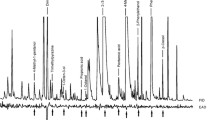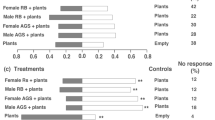Abstract
Chemical composition of volatiles emitted from fresh mouse carcasses (laboratory mice, Mus musculus) was studied using solid sample injection technique (solid-phase micro-extraction), two-dimensional gas chromatography with time of flight mass spectrometric detection and gas chromatography with electroantennographic detection. Electroantennography (EAG) and laboratory olfactometric behavioural observations were used to study the antennal sensitivity to identified infochemicals and their attractiveness for burying beetles Nicrophorus vespillo and Nicrophorus vespilloides (Silphidae: Nicrophorinae). Chemical analysis showed that immediately after death, emitted volatiles did not differ from those emitted by a living organism. However, in the course of time, sulphur-containing chemicals, specifically methanethiol, methyl thiolacetate, dimethyl sulphide, dimethyl disulphide and dimethyl trisulphide appear. EAG measurements revealed antennal sensitivity to these compounds. Behavioural tests in laboratory olfactometer showed that dimethyl sulphide, dimethyl disulphide and dimethyl trisulphide are highly attractive to both studied species. The data suggest that sulphur-containing chemicals are involved in mediating the fresh carcass attractiveness for N. vespillo and N. vespilloides.







Similar content being viewed by others
References
Abbot CE (1927) Experimental data on the olfactory sense of Coleoptera, with special reverence to the Necrophori. Ann Entomol Soc Am 20:207–215
Al Rouz H, Thibout E (1988) Analyse en olfactomètre de l’attraction des larves d’Acrolepiopsis assectella par des substances allelochimiques. Entomol Exp Appl 47:231–237. doi:10.1007/BF00352209
Anderson RS (1982) Resource partitioning in the carrion beetle (Coleoptera: Silphidae) fauna of southern Ontario: ecological and evolutionary considerations. Can J Zool 60:1314–1325. doi:10.1139/z82-178
Anderson RS, Peck SB (1984) Bionomics of Nearctic species of Aclypea Reitter: phytophagous “carrion” beetles (Coleoptera: Silphidae). Pan-Pac Entomol 60:248–255
Anderson RS, Peck SB (1985) The insects and arachnids of Canada, part 13. The Carrion beetles of Canada and Alaska (Coleoptera: Silphidae and Agyrtidae). Research Branch, Agriculture Canada, Ottawa
Anderson RS, Peck SB (1986) Geographic patterns of colour variation in North American burying beetles (Coleoptera; Silphidae). J Nat Hist 20:283–297. doi:10.1080/00222938600770241
Auger J, Lecomte C, Paris J, Thibout E (1989a) Identification of leek-moth and diamondback-moth frass volatiles that simulate parasitoid, Diadromus pulchellus. J Chem Ecol 15:1391–1398. doi:10.1007/BF01014838
Auger J, Lecomte C, Thibout E (1989b) Leek odor analysis by gas chromatography and identification of the most active substance for the leek moth, Acrolepiopsis assectella. J Chem Ecol 15:1847–1854. doi:10.1007/BF01012271
Barlett J (1987) Evidence for a sex attractant in burying beetles. Ecol Entomol 12:471–472. doi:10.1111/j.1365-2311.1987.tb01028.x
Baxter D, Hughes PS (2001) Beer: quality, safety and nutritional aspects. RSC Paperback, Royal Society of Chemistry, London
Boeckh J (1962) Elektrophysiologische Untersuchungen an einzelnen Geruchsrezeptoren auf den Antennen des Totengräbers (Necrophorus, Coleoptera). Z Vgl Physiol Berl 46:212–248. doi:10.1007/BF00341551
Borg-Karlson AK, Englund FO, Unelius CR (1994) Dimethyl oligosulfides, major volatiles released from Sauromatum guttatum and Phallus impudicus. Phytochemistry 35:321–323. doi:10.1016/S0031-9422(00)94756-3
Cuer A, Dauphin G, Kergomard A, Dumont JP, Adda J (1979) Production of S-methylthioacetate by Brevibacterium linens. Appl Environ Microbiol 38:332–334
Dethier VG (1947) The role of the antennae in the orientation of carrion beetles to odors. J NY Entomol Soc 55:285–293
DeVault TL, Brisbin IL Jr, Rhodes OE Jr (2004) Factors influencing the acquisition of rodent carrion by vertebrate scavengers and decomposers. Can J Zool 82:502–509. doi:10.1139/z04-022
Eggert AK (1992) Alternative male mate-finding tactics in burying beetles. Behav Ecol 3:243–254. doi:10.1093/beheco/3.3.243
Eggert AK, Müller JK (1989a) Mating success of pheromone-emitting Necrophorus males: do attracted females discriminate against resource owners? Behaviour 110:248–257. doi:10.1163/156853989X00493
Eggert AK, Müller JK (1989b) Pheromone-mediated attraction in burying beetles. Ecol Entomol 14:235–237. doi:10.1111/j.1365-2311.1989.tb00774.x
Eggert AK, Müller JK (1997) Biparental care and social evolution in burying beetles: Lessons from the larder. In: Choe JC, Crespi BJ (eds) The evolution of social behavior in insects and arachnids. Cambridge University Press, Cambridge, New York, pp 216–236
Ernst KD (1972) Sensillum coelosphaericum, die Feinstruktur eines neuen olfaktorischen Sensillentyps. Z Zellforsch Mikrosk Anat 132:95–106. doi:10.1007/BF00310299
Grassberger M, Frank C (2004) Initial study of arthropod succession on pig carrion in a central European urban habitat. J Med Entomol 41:511–523
Haberer W, Schmitt T, Peschke K, Schreier P, Müller JK (2008) Ethyl 4-methyl heptanoate: a male-produced pheromone of Nicrophorus vespilloides. J Chem Ecol 34:94–98. doi:10.1007/s10886-007-9406-y
Halffter G, Anduaga S, Huerta C (1983) Nidification des Nicrophorus (Col. Silphidae). Bull Soc Entomol Fr 88:648–666
Hoskovec M, Kalinová B, Konečný K, Koutek B, Vrkoč J (1993) Structure-activity correlations among analogs of the currant clearwing moth pheromone. J Chem Ecol 19:737–750. doi:10.1007/BF00985005
Hoskovec M, Grygarová D, Cvačka J, Streinz L, Zima J, Verevkin SP, Koutek B (2005) Determining the vapour pressures of plant volatiles from gas chromatographic retention data. J Chrom A 1083:161–172. doi:10.1016/j.chroma.2005.06.006
Janzen DH (1977) Why fruits rot, seeds mold, and meat spoils. Am Nat 111:691–713. doi:10.1086/283200
Jojola-Elverum SM, Shivik JA, Clark L (2001) Importance of bacterial decomposition, and carrion substrate to foraging, brown treesnakes. J Chem Ecol 27:1315–1331. doi:10.1023/A:1010357024140
Jürgens A, Dötterl S, Meve U (2006) The chemical nature of fetid floral odours in stapeliads (Apocynaceae-Asclepiadoideae-Ceropegieae). New Phytol 172:452–468. doi:10.1111/j.1469-8137.2006.01845.x
Kadota H, Ishida Y (1972) Production of volatile sulfur compounds by microorganisms. Annu Rev Microbiol 26:127–138. doi:10.1146/annurev.mi.26.100172.001015
Kite GC, Hetterschieid WLA (1997) Inflorescence odours of Amorphophallus and Pseudodracontium (Araceae). Phytochemistry 46:71–75. doi:10.1016/S0031-9422(97)00221-5
Kočárek P (1997) The occurrence of Silphidae and Leiodidae: Cholevinae (Coleoptera) in the Litovelské Pomoraví Protected Lanscape Area. Zprávy Vlastivěd Muz v Olomouci 275:17–29 (in Czech, English abstract)
Kočárek P (2000) A pitfall trap for carrion ecology studies. Biologia (Bratisl) 55:575–577
López del Castillo-Lozano M, Mansour S, Tâche R, Bonnarme P, Landaud S (2008) The effect of cysteine on production of volatile sulfur compounds by cheese-ripening bacteria. Int J Food Microbiol 122:321–327
Milne LJ, Milne M (1976) The social behavior of burying beetles. Sci Am 235:84–89
Müller JK, Eggert AK, Furlkröger E (1990) Clutch size regulation in the burying beetle Necrophorus vespilloides Herbst (Coleoptera: Silphidae). J Insect Behav 3:265–270. doi:10.1007/BF01417917
Nagano M, Suzuki S (2007) Effect of carcass size and male presence on clutch size in Nicrophorus quadripunctatus (Coleoptera: Silphidae). Entomol Sci 10:245–248. doi:10.1111/j.1479-8298.2007.00220.x
Ollerton J, Raguso RA (2006) The sweet stench of decay. New Phytol 172:379–381. doi:10.1111/j.1469-8137.2006.01903.x
Parliment TH, Kolor MG, Rizzo DJ (1982) Volatile components of limburger cheese. J Agric Food Chem 30:1006–1008. doi:10.1021/jf00114a001
Peck SB (1990) Insecta: Coleoptera Silphidae and the associated families Agyrtidae and Leiodidae. In: Dindal DL (ed) Soil biology guide. Wiley, New York, pp 1113–1136
Peck SB, Kaulbars MM (1987) A synopsis of the distribution and bionomics of the carrion beetles (Coleoptera: Silphidae) of the conterminous United States. Proc Entomol Soc Ont 118:47–81
Petruška F (1975) The effect of predominating winds on the flight of some species of beetles from the group of Silphidae into pitfall traps (Col. Silphidae). Acta Universitatis Palackianae Olomucensis. Facultas Rerum Natur 51:155–175
Pfrommer A, Krell FT (2004) Who steals the eggs? Coprophanaeus telamon (Erichson) buries decomposing eggs in western Amazonian Rain Forest (Coleoptera: Scarabaeidae). Coleopt Bull 58:21–27. doi:10.1649/585
Pukowski E (1933) Ökologische Untersuchungen an Necrophorus F. Z Morphol Oekol Tiere 27:518–586. doi:10.1007/BF00403155
Pukowski E (1934) Die Brutpflege des Totengräbers. Entomol Blatt 30:109–112
Raguso RA (2004) Flowers as sensory billboards: progress towards an integrated understanding of floral advertisement. Curr Opin Plant Biol 7:434–440. doi:10.1016/j.pbi.2004.05.010
Raguso RA (2008) Wake up and smell the roses: the ecology and evolution of floral scent. Annu Rev Ecol Evol Syst 39:549–569. doi:10.1146/annurev.ecolsys.38.091206.095601
Ratcliffe BC (1996) The carrion beetles (Coleoptera: Silphidae) of Nebraska. Bull Univ Nebr State Mus 13:1–100
Roelofs WL (1984) Electroantennogram assays: rapid and convenient screening procedures for pheromones. In: Hummel HE, Miller TA (eds) Techniques in pheromone research. Springer, New York, pp 131–159
Růžička J (2007) Fauna Europaea: Silphidae. In: Alonso-Zarazaga MA, Audisio P (eds) Fauna Europaea: Coleoptera, Beetles. Fauna Europaea version 1.3. http://www.faunaeur.org
Růžička J, Schneider J (2004) Family Silphidae Latreille, 1807. In: Löbl I, Smetana A (eds) Catalogue of Palaearctic Coleoptera, vol. 2: Hydrophiloidea–Histeroidea—Staphylinoidea. Apollo Books, Steensrup, pp 229–237
Scott MP (1998) The ecology and behavior of burying beetles. Annu Rev Entomol 43:595–618. doi:10.1146/annurev.ento.43.1.595
Segal W, Starkey RL (1969) Microbial decomposition of methionine and identity of the resulting sulfur products. J Bacteriol 98:908–913
Sikes DS (2005) Silphidae Latreille, 1807. In: Beutel RG, Leschen RAB (eds) Handbook of zoology, volume IV: Arthropoda: Insecta, Part 38: Coleoptera, Beetles. Volume 1: morphology and systematics (Archostemata, Adephaga, Myxophaga, Polyphaga partim). Walter de Gruyer, Berlin, pp 288–296
Smisetf PT, Moore AJ (2002) Does resource availability affect offspring begging and parental provisioning in a partially begging species? Anim Behav 63:577–585. doi:10.1006/anbe.2001.1944
Smith RJ, Heese B (1995) Carcass selection in a high altitude population of the burying beetle, Nicrophorus investigator (Silphidae). Southwest Nat 40:50–55
Stensmyr MC, Urru I, Collu I, Celander M, Hansson BS, Angioy AM (2002) Pollination: rotting smell of dead-horse arum florets. Nature 420:625–626. doi:10.1038/420625a
Steullet P, Guerin PM (1992) Perception of breath components by the tropical bont tick, Amblyomma variegatum Fabricius (Ixodidae). J Comp Physiol [A] 170:677–685. doi:10.1007/BF00198977
Stránský K, Valterová I (1999) Release of volatiles during the flowering period of Hydrosme rivieri (Araceae). Phytochemistry 52:1387–1390. doi:10.1016/S0031-9422(99)00247-2
Šustek Z (1981) Key to identification of insects: Carrion beetles of Czechoslovakia (Coleoptera, Silphidae). Zprávy Československé Společnosti Entomologické při ČSAV, Klíče k určování hmyzu 2:1–47 (in Czech)
Thomas CJ, McMeekin TS (1981) Production of off odours by isolates from poultry skin with particular reference to volatile sulphides. J Appl Bacteriol 198:529–534
Trumbo ST (1994) Interspecific competition, brood parasitism, and the evolution of biparental cooperation in burying beetles. Oikos 69:241–249. doi:10.2307/3546144
Trumbo ST, Fernandez AG (1995) Regulation of brood size and cues employed to assess resource size by burying beetles. Ethol Ecol Evol 7:313–322
Waldow U (1973) Elektrophysiologie eines neuen Aasgeruchrezeptors und seine Bedeutung für das Verhaltern des Totengräbers (Necrophorus). J Comp Physiol 83:415–424. doi:10.1007/BF00696356
Wasserman SL, Itagaki H (2003) The olfactory responses of the antenna and maxillary palp of the fleshfly, Neobellieria bullata (Diptera: Sarcophagidae) and their sensitivity to blockage of nitric oxide synthase. J Insect Physiol 49:271–280. doi:10.1016/S0022-1910(02)00288-3
Watson EJ, Carlton CE (2004) Insect succession and decomposition of wildlife carcasses during Fall and Winter. J Med Entomol 42:193–203. doi:10.1603/0022-2585(2005)042[0193:ISADOW]2.0.CO;2
Wawrzkiewicz K, Ziókowska G, Wawrzkiewiczyna J (1997) In vitro biodegradation of hair from different animal species by Microsporum canis. Int Biodeter Biodegr 39:15–25. doi:10.1016/S0964-8305(96)00040-6
Wilson DS, Knollenberg WG (1984) Food discrimination and ovarian development in burying beetles (Coleoptera: Silphidae: Nicrophorus). Ann Entomol Soc Am 77:165–170
Woodard CBS (2006) Odor masking of a vertebrate carcass by a burying beetle (Nicrophorus marginatus). Master’s thesis, Texas Tech University, Lubbock, TX
Xu H, Suzuki N (2001) Effects of carcass size and parental feeding on reproductive success of the burying beetle Nicrophorus quadripunctatus (Coleoptera Silphidae). Entomol Sci 4:217–222
Zoecklein B (2005) The good volatile sulfur compounds. Enology Notes 101. http://www.fst.vt.edu/extension/enology/EN/101.html
Acknowledgement
We are highly indebted to Jarmila Titzenthalerová and to Ondřej Blažek (in memoriam) for their skilful technical assistance in insect handling and electrophysiological experiments. We also thank to Miroslav Šálek (Faculty of Environmental Sciences, Czech University of Life Sciences, Prague) for help in statistical calculations. Special thanks are addressed to Yvonne Kavanagh (Dublin and IOCB Prague) for the language check of this paper. We very much thank the anonymous referees for constructive criticism of the manuscript. This work was supported by research project Z4-055-905 (Institute of Organic Chemistry ASCR, v.v.i.) and by grant CULS-IGA 200741110031 (Faculty of Environmental Sciences, Czech University of Life Sciences, Prague).
Author information
Authors and Affiliations
Corresponding author
Rights and permissions
About this article
Cite this article
Kalinová, B., Podskalská, H., Růžička, J. et al. Irresistible bouquet of death—how are burying beetles (Coleoptera: Silphidae: Nicrophorus) attracted by carcasses. Naturwissenschaften 96, 889–899 (2009). https://doi.org/10.1007/s00114-009-0545-6
Received:
Revised:
Accepted:
Published:
Issue Date:
DOI: https://doi.org/10.1007/s00114-009-0545-6




